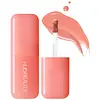What's inside
What's inside
 Key Ingredients
Key Ingredients

 Benefits
Benefits

 Concerns
Concerns

 Ingredients Side-by-side
Ingredients Side-by-side

Hydrogenated Polyisobutene
EmollientHydrogenated Poly(C6-14 Olefin)
EmollientMica
Cosmetic ColorantOctyldodecanol
EmollientDiisostearyl Malate
EmollientCalcium Titanium Borosilicate
AbrasiveTrimethylsiloxysilicate
EmollientIsododecane
EmollientHydrogenated Styrene/Isoprene Copolymer
Silica
AbrasiveDextrin Palmitate
EmulsifyingDisteardimonium Hectorite
StabilisingSorbitan Sesquioleate
EmulsifyingPhenoxyethanol
PreservativePropylene Carbonate
SolventParfum
MaskingTriethoxycaprylylsilane
Aluminum Hydroxide
EmollientPolyhydroxystearic Acid
EmulsifyingTin Oxide
AbrasivePentaerythrityl Tetra-Di-T-Butyl Hydroxyhydrocinnamate
AntioxidantTocopherol
AntioxidantTitanium Dioxide
Cosmetic ColorantIron Oxides
CI 15850
Cosmetic ColorantHydrogenated Polyisobutene, Hydrogenated Poly(C6-14 Olefin), Mica, Octyldodecanol, Diisostearyl Malate, Calcium Titanium Borosilicate, Trimethylsiloxysilicate, Isododecane, Hydrogenated Styrene/Isoprene Copolymer, Silica, Dextrin Palmitate, Disteardimonium Hectorite, Sorbitan Sesquioleate, Phenoxyethanol, Propylene Carbonate, Parfum, Triethoxycaprylylsilane, Aluminum Hydroxide, Polyhydroxystearic Acid, Tin Oxide, Pentaerythrityl Tetra-Di-T-Butyl Hydroxyhydrocinnamate, Tocopherol, Titanium Dioxide, Iron Oxides, CI 15850
Mica
Cosmetic ColorantCaprylyl Methicone
Skin ConditioningDimethicone
EmollientDimethicone/Vinyl Dimethicone Crosspolymer
Skin ConditioningSqualane
EmollientTriethoxycaprylylsilane
Cucumis Sativus Seed Extract
Skin ConditioningHelianthus Annuus Seed Oil
EmollientWithania Somnifera Root Extract
Skin ConditioningHordeum Vulgare Extract
EmollientAluminum Hydroxide
EmollientPhytosterols
Skin ConditioningGlycerin
HumectantDicalcium Phosphate
AbrasiveCI 77491
Cosmetic ColorantCI 77492
Cosmetic ColorantCI 77499
Cosmetic ColorantCI 15850
Cosmetic ColorantCI 77891
Cosmetic ColorantCI 77007
Cosmetic ColorantMica, Caprylyl Methicone, Dimethicone, Dimethicone/Vinyl Dimethicone Crosspolymer, Squalane, Triethoxycaprylylsilane, Cucumis Sativus Seed Extract, Helianthus Annuus Seed Oil, Withania Somnifera Root Extract, Hordeum Vulgare Extract, Aluminum Hydroxide, Phytosterols, Glycerin, Dicalcium Phosphate, CI 77491, CI 77492, CI 77499, CI 15850, CI 77891, CI 77007
 Reviews
Reviews

Ingredients Explained
These ingredients are found in both products.
Ingredients higher up in an ingredient list are typically present in a larger amount.
Aluminum Hydroxide is a form of aluminum. It can be naturally found in nature as the mineral gibbsite. In cosmetics, Aluminum Hydroxide is used as a colorant, pH adjuster, and absorbent.
As a colorant, Aluminum Hydroxide may add opacity, or reduce the transparency. Aluminum hydroxide is contains both basic and acidic properties.
According to manufacturers, this ingredient is an emollient and humectant. This means it helps hydrate the skin.
In medicine, this ingredient is used to help relieve heartburn and help heal ulcers.
There is currently no credible scientific evidence linking aluminum hydroxide in cosmetics to increased cancer risk.
Major health organizations allow the use of aluminum hydroxide in personal care products and have not flagged it as a carcinogenic risk at typical usage levels.
Learn more about Aluminum HydroxideCi 15850 is the pigment color red. It is an azo dye and created synthetically.
Azo dyes need to be thoroughly purified before use. This allows them to be more stable and longer-lasting.
This ingredient is common in foundations, lipsticks, and blushes. This color is described as brown/orangey red.
It has many secondary names such as Red 6 and Red 7. According to a manufacturer, Red 6 usually contains aluminum.
Learn more about CI 15850Mica is a naturally occurring mineral used to add shimmer and color in cosmetics. It can also help improve the texture of a product or give it an opaque, white/silver color.
Serecite is the name for very fine but ragged grains of mica.
This ingredient is often coated with metal oxides like titanium dioxide. Trace amounts of heavy metals may be found in mica, but these metals are not harmful in our personal products.
Mica has been used since prehistoric times throughout the world. Ancient Egyptian, Indian, Greek, Roman, Aztec, and Chinese civilizations have used mica.
Learn more about MicaTriethoxycaprylylsilane is a silicone used to bind and stabilize ingredients.
As an emulsifier, it helps prevent ingredients from separating. This can help elongate the shelf life of products.
Triethoxycaprylylsilane is often used to coat mineral sunscreens ingredients to help give a better feel. It also helps reduce oxidative stress in sunscreens.
Learn more about Triethoxycaprylylsilane